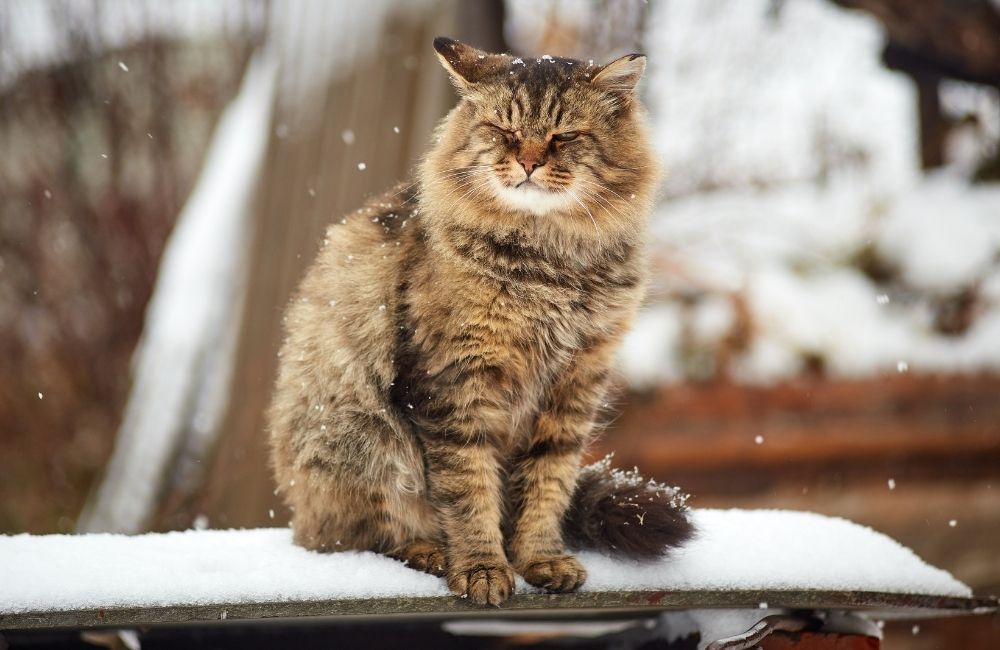Despite their air of apparent nonchalance about life, cats are sensitive to their surroundings.
One environmental factor that affects them acutely is the weather.
Leaving a cat to face the elements on its own can spell disaster for your feline.
Regardless of what season it is and what type of weather conditions your area is experiencing, finding ways to help your cat adapt to and survive its environment is essential.

Here are some tips to prepare your cat for different weather types:
Table of Contents
Summer heat
The most significant risk hot summer weather presents to your feline is dehydration. Cats tend not to drink enough water, preferring to get most of their liquid intake from their food. This lack of fluid intake makes cats susceptible to kidney and bladder troubles, especially urinary tract (UT) infections.
Including natural UT soft chews for cats into your kitty’s supplement regimen can prevent this from becoming a feline health challenge. You can choose the best multivitamins for your meow friend from brands like Scruffy Paws Nutrition, Only Natural Pet, VetriScience, Pet Naturals, and Nature Vet to ensure optimum health and a longer life.
In addition to the above measure, ensure that your cat has free access to a fresh water supply. Have more than one drinking station set up during the hot summer months, such as one indoors and another outside. Check your cat’s water bowls at least once a day to ensure that they have sufficient water. Additionally, consider feeding your cat additional moist food instead of dry food, as moist food contains a higher percentage of fluids, vital for your cat to remain fully hydrated.
Extreme heat
Sometimes summer weather conditions go well beyond average norms, such as during heatwaves. Such conditions could be dangerous for your cat, and taking precautions is essential. Cats that like to spend time outdoors should only be allowed to do so in the early morning and again at night. During these times, temperatures are at their lowest and less likely to cause your cat discomfort. Hot pavements and roofs can damage a kitty’s paws and should be avoided.
Another place to avoid is the interior of your car. Taking your cat along for a quick ride to the supermarket may seem innocuous enough, but it could have lasting implications for a feline. A locked car’s interior temperature rises rapidly, which could prove harmful, if not fatal, for a kitty.
Winter cold
Once they feel the slightest chill, cats start looking for somewhere warmer to spend their time. Unfortunately, this can get them into trouble, such as when they seek refuge atop a warm car engine or get locked into sheds and garages. During the cold winter months, pound your car’s hood once or twice before starting it to wake a napping cat that took refuge from the cold under the hood.
The best place for any pet when harsh winter temperatures strike is indoors. Ensure that your cat remains inside and does not spend too much time outside. As most felines do not need to go outdoors for potty purposes, a kitty would prefer to be inside and will not pester you for some outdoor time like a dog would. Despite being within the confines of your home, a cat might still find conditions somewhat chilly. Therefore, provide a feline with a warm blanket, basket, or both to enjoy some long, cozy naps. Always ensure that the cat is indoors before you leave the house.
Natural disasters
Like most animals, cats might flee in the face of a natural disaster, such as flooding, a tornado, or an earthquake. Their survival instincts kick in, spurring them to move away from danger. However, cats with deep attachments to their human owners might stick close by, not wanting to let them out of their sight.
If you need to leave your home after a severe weather event, take your cat with you. Have a disaster pack ready, including items such as a cat carrier, proof of your cat’s vaccinations, a two-week food supply, a blanket, and your cat’s preferred treat. In the unfortunate event that your cat is nowhere to be found when you evacuate, leave a food supply somewhere near your home. Have a photograph handy to make lost posters and show them at shelters in case your cat winds up in one. Cats are hardy survivors, and returning to the house and looking for yours should yield positive results.
Prepare for pests
The summer months are more likely to allow an infestation of ticks or fleas on your feline. These pests breed well in warmer conditions. Cat owners should not wait until they strike before acting. Instead, take preventative measures like using tick and flea repellants, including a collar.
Ticks and fleas can be a major source of discomfort for a feline and should be avoided wherever possible. Book your feline’s annual vaccinations for spring each year and ask the veterinarian for advice on tick and flea products that work effectively. Other pests to avoid include tapeworms that your cat might get from eating spoiled food they might find in the trash.
As a feline parent, it is your responsibility to protect your cat from poor weather conditions and keep them healthy and hydrated all year round. When you follow these simple tips, you are sure to have a happy kitty around who unconditionally purrs for you.